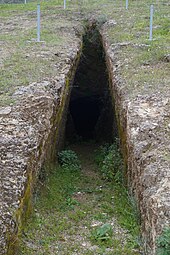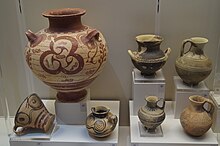Mycenaean cemetery of Palea Epidavros
The Mycenaean cemetery of Palea Epidavros ( Greek Μυκηναϊκό Νεκροταφείο Παλαιάς Επιδαύρου ) is located west of the Greek city of Palea Epidauros on the eastern slope of the hill Katarachi. Over 30 Mycenaean chamber tombs have so far been discovered at the site, which is also called Nera .
exploration
When the Greek archaeologist Valerios Stais traveled from Palea Epidavros to the Asclepion of Epidauros in 1887 , he discovered the dromos of a tomb on the outskirts . He applied for an excavation permit and was able to begin excavations in August 1888. He explored seven chamber graves. A note by Stais on Mycenaean tonidoles from chamber tombs in Epidaurus suggests that further tombs were explored between 1888 and 1895. However, there is no publication of the results. In addition, Vassilis L. Aravantinos stated that when he wanted to publish the finds from the first excavation, only 10 of the 16 finds stored in the National Archaeological Museum could be found and identified. In December 1973 a small chamber grave was destroyed during construction work. Two small clay vessels were found here. Four more graves were discovered in 1978/9. Five graves were uncovered during construction work in the spring of 1981. However, since it was only noticed late that they had come across Mycenaean chamber tombs, they were badly damaged. The remaining remains were secured in an emergency excavation by the archaeologist Konstantina Kaza-Papageorgiou. The following May, the fifth grave in the extreme southwest of Katarachi was examined more closely by the archaeologist Dina Kaza. In 1994 four more chamber graves and graves from later times east of the cemetery were explored.
description
The seven chamber graves (graves A – G), which Valerios Stais uncovered in 1888, are located on the fenced-in area on the Odos Ippokratous . Like all the other Mycenaean tombs discovered here so far, they are carved into the rock from the east into the slope that rises to the west. Since the graves were very similar, Stais only described one grave in detail. Presumably this was grave G. The drom was 6 m long and 1.20 m wide at the bottom. The side walls were inclined slightly inwards and the dromos descended towards the grave entrance, so that the side walls strived together with increasing depth and were only 0.25 m to 0.50 m apart directly in front of the 1.50 m high grave facade. The entrance was walled up with a 2 m thick dry stone wall, this showed that the grave had not been looted. Behind the door ( Stomion ) was a grave chamber ( Thalamos ) of approximately circular outline of 4 m in diameter with a height of 2 m at the highest point. In the grave, four skeletons were buried next to potsherds with their heads facing east. To the right of each skull was a small vessel and one with a bronze spearhead. Parallel to this he found four similar graves, which were, however, somewhat smaller and less carefully laid out. The dromos of these graves was at least five meters long. All but one were still provided with the original locking wall. Many bones and pottery shards were found on the back wall of the burial chambers. The pottery shards could be put together to form complete vessels. Stais concluded that the graves had been used for several generations. Before the new burial, the clay pots from the previous burial were smashed and all remains and bones were moved to the back wall to make room for the new body.
Stais also found two smaller chamber graves. One contained only a skeleton in a crouching position. He found the skull between the lower leg bones. Based on the additions, a bronze clasp and two spindle whorls , he suspected that a woman had been buried here. The finds from the graves date from the end of the Late Helladic III A2 to SH III C (1340-1050 BC)
The four chamber tombs, which were discovered in 1994, are located about 5 m west of the fenced area. They are oriented the same as the ones previously described. The northernmost grave 1 has a 4.90 m long drom that is only slightly descending. The width at floor level increases from 0.85 m to 1 m, while the inwardly inclined side walls approach from 0.85 m to 0.40 m. The grave facade is 2.40 m high and there is an entrance 1 m high, 0.50 m wide and 0.90 m deep. This was still closed with stones during the excavation. The burial chamber has an irregular shape measuring 1.10 m by 1.25 m. A skeleton was found lying right at the entrance, another was behind it. Three more burials and vessels had been cleared from the south side wall. The grave goods included a conical and four pressed jugs , two cylindrical and two spherical alabastras , four steatite buttons and a steatite seal. Based on the ceramic, the grave can be dated to SH III B.
4.50 m south of grave 1 is grave 2. The dromos is 3.20 m long and widens towards the grave from 1.20 m to 1.50 m. The Dromos runs almost horizontally, but after one meter there is a step 0.55 m down. The entrance is 1 m high, 0.55 m wide and 0.30 m deep. The ceiling of the 2.40 × 2.50 m rectangular chamber has collapsed. The bones of 3-4 dead people and numerous pottery shards were found on the south wall. In the middle of the chamber there is a grave pit measuring 0.90 × 0.50 × 0.30 m. In it were found a skeleton, shells, glass beads, clay buttons, a bronze dagger and three bronze nails. The shards of 32 clay pots from SH II – III A were found. Among them were also an amphora and a jug from the Cyclades .
To the south at a distance of 2.80 m from grave 2 lies grave 3. The dromos begins in the east with a step 0.40 m high, is 2.40 m long and 1.10 m wide. The entrance is 0.90 m high, 0.70 m wide and 0.40 m deep. The 2.80 × 2.50 m large, rectangular burial chamber has also collapsed. On the north wall two skeletons were found that had been cleared to one side and three on the south wall with the associated clay vessels. In the middle there is a 1.20 × 0.60 × 0.60 m pit that was covered with limestone slabs. In the pit, next to a corpse, three clay vessels, a bronze spearhead, a clay button, shells, blue, white and dark blue glass beads and glass plates were found. In addition to these finds, which date to SH II – III A, a glazed tile from the Byzantine period was also found.
The southernmost grave 4 is 3.60 m away from grave 3. It has a clearly inclined, 5.80 m long dromos. The width at floor level widens from 0.90 m to 1.10 m, while the inwardly inclined side walls approach from 0.90 m to 0.40 m. The entrance measures 1.20 × 0.55 × 0.95 m and the facade is 2.90 m high. The rectangular chamber is 3 m wide and 2 m deep and has partially collapsed. The remains of two burials, including ceramics, were found on the north wall. Bones were also found in the south, but without grave goods. Two skulls, two alabastra, five steatite buttons and shells were found in the west. The grave was used by SH III A to SH III B1.
Web links
Individual evidence
- ↑ Valerios Stais: Άνασκαφαί εν Πάλαια Επίδαυρω in Aρχαιολογικον Δελτιον , Athens 1888, pp. 155–158 ( online )
- ^ Franz Winter : The sites of discovery. Peloponnese. Epidaurus. in Reinhard Kekulé von Stradonitz : The ancient terracottas. The types of figural terracottas. , Volume 3, Berlin 1903, p. XXVIII ( online )
- ↑ Valerios Stais: Προϊστορικοι Συνοικισμοι εν Αττικη και Αιγινη in Αρχαιολογική Εφημερίς , 1895, p. 202 ( online )
- ↑ Vassilis L. Aravantinos: Μυκηναϊκά εκ Παλαιάς Επιδαύρου in Aρχαιολογικον Δελτιον Volume 29 (1974), Part A, Athens 1977, pp. 70-87 ( online )
- ↑ Valerios Stais: Άνασκαφαί εν Πάλαια Επίδαυρω in Aρχαιολογικον Δελτιον , Athens 1888, pp. 155-158
- ↑ Vassilis L. Aravantinos: Μυκηναϊκά εκ Παλαιάς Επιδαύρου in Aρχαιολογικον Δελτιον Volume 29 (1974), Part A, Athens 1977, pp. 70-87
- ↑ Christos Piteros: Παλαιά Επίδαυρος. Οικόπεδο Δημ. Κουτσελόπουλου in Aρχαιολογικον Δελτιον Volume 49 (1994), Part B1, Athens 1999, pp. 156-8
Coordinates: 37 ° 38 ′ 6.5 ″ N , 23 ° 9 ′ 9.5 ″ E




